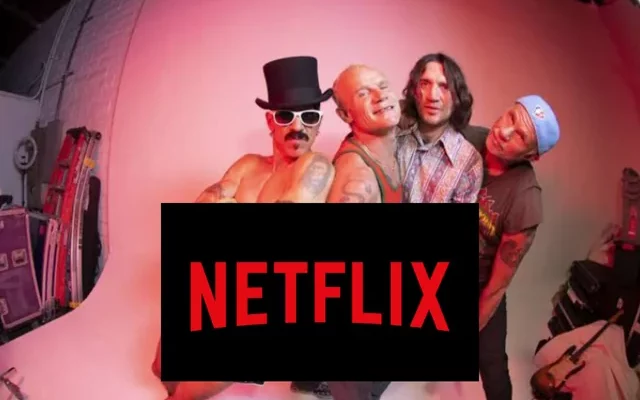Netflix has once again delivered a cultural moment that fans around the world had been anxiously awaiting. After months of rumors, speculation, and countless discussions across fan forums and social media, the streaming giant has finally released the highly anticipated documentary chronicling the story of one of the most iconic and influential rock bands of all time—the Red Hot Chili Peppers. For decades, the Chili Peppers have been more than just a band; they have been a phenomenon, reshaping the soundscape of modern rock, blending funk, punk, psychedelic, and alternative rock into a distinctive sound that has become synonymous with both rebellion and reinvention. This Netflix documentary arrives at a time when nostalgia for the 1990s and early 2000s is running high, while the band itself remains active and relevant on the global stage. It is more than just a music film; it is a cultural exploration of art, struggle, brotherhood, addiction, and redemption.
The documentary begins by tracing the band’s roots back to Los Angeles in the early 1980s, when a group of young musicians with boundless energy and little to lose began experimenting with sound and identity. Anthony Kiedis, Flea, Hillel Slovak, and Jack Irons, all childhood friends in one way or another, laid the foundation for what would become the Red Hot Chili Peppers. What Netflix does so well in this production is strip away the myth while simultaneously celebrating it. Rare archival footage of early gigs at dingy clubs, grainy rehearsal tapes, and even candid personal moments are interwoven with interviews from the surviving members and key figures in the band’s history. Viewers are invited not only to witness but to feel the chaos, camaraderie, and raw determination that gave birth to the Chili Peppers’ unique sound.
The story of the Chili Peppers has always been one of duality. On one hand, there is joy, freedom, and wild creative expression. On the other, there are battles with inner demons, losses too heavy to bear, and struggles with addiction that nearly tore the band apart multiple times. The Netflix documentary does not shy away from these darker chapters. Instead, it confronts them directly. The tragic death of guitarist Hillel Slovak in 1988 from a heroin overdose is depicted with sensitivity and respect, while also acknowledging how his passing became a turning point for the band. For Flea and Kiedis, Slovak’s death was both a crushing personal loss and a moment that forced them to reconsider the direction of their lives and music.
Another strength of the documentary is the way it humanizes the band members beyond the larger-than-life personas they have carried on stage. Anthony Kiedis, often seen as the enigmatic frontman, opens up about his struggles with addiction and his relationship with fame. Flea, the eccentric bassist, reveals layers of vulnerability, sharing how his love of music became both his sanctuary and his salvation. Chad Smith, the powerhouse drummer who joined in 1988, provides insight into what it was like to enter an already turbulent band and help anchor it musically and emotionally. Perhaps most striking are the sections featuring guitarist John Frusciante. His relationship with the band has been tumultuous, marked by departures and returns, but his artistry has been central to the band’s greatest triumphs. His candid reflections on creativity, self-destruction, and healing provide some of the most poignant moments in the film.
The documentary also does justice to the Chili Peppers’ musical evolution. From the raw, funky chaos of their early records to the global success of “Blood Sugar Sex Magik” and the reflective beauty of “Californication,” the Netflix production charts how the band constantly reinvented themselves without losing their identity. Music critics, producers, and fellow artists provide commentary that underscores just how revolutionary the Chili Peppers were. Rick Rubin, the legendary producer who played a crucial role in shaping the band’s sound, appears prominently in the film. His insights into the creative process, particularly during the recording of their landmark albums, add depth to the narrative and give viewers a behind-the-scenes look at how some of rock’s most beloved songs came to life.
But the film is not just about the past. It also situates the Chili Peppers firmly in the present, showing how they continue to inspire new generations of fans while still pushing themselves creatively. Scenes from recent tours, recording sessions, and candid band interactions reveal that, despite the decades and the hardships, the fire still burns brightly. The band members reflect on what it means to grow older in the music industry, to continue performing songs that defined their youth while still seeking fresh artistic challenges. There is an honesty in these reflections that resonates deeply, reminding viewers that longevity in rock is not merely about survival but about evolution.
What makes the Netflix documentary truly special is its balance of intimacy and grandeur. On one level, it is a deeply personal story about four individuals navigating fame, loss, addiction, and redemption. On another, it is a sweeping cultural history of one of the most important bands of the last forty years. The filmmakers manage to capture the energy of live performances, the intimacy of personal struggles, and the broader cultural impact of the Chili Peppers’ music. For long-time fans, it feels like a long overdue celebration of everything the band has meant over the years. For newcomers, it serves as a powerful introduction to a group whose influence can be heard in countless artists across genres.
The fan response to the documentary has been electric. Social media platforms have been flooded with reactions ranging from nostalgic reflections to newfound appreciation. Many fans have shared personal stories of how the Chili Peppers’ music carried them through difficult times or defined pivotal moments in their lives. This emotional resonance underscores just how deeply the band’s music has woven itself into the fabric of modern culture. Songs like “Under the Bridge,” “Scar Tissue,” and “Can’t Stop” are not just hits—they are cultural touchstones that continue to speak to people across generations.
Critics have also praised the documentary for its unflinching honesty and cinematic craftsmanship. Unlike many band documentaries that tend to gloss over the darker moments, Netflix has embraced a raw, authentic storytelling approach. The use of archival material feels purposeful rather than gratuitous, and the pacing allows viewers to fully absorb both the highs and the lows. The soundtrack, unsurprisingly, is a highlight, blending live performances, studio recordings, and even unreleased material to create an immersive audio-visual experience.
In many ways, the documentary is a meditation on resilience. The Red Hot Chili Peppers’ story could have ended many times—after Slovak’s death, during Kiedis’s struggles with addiction, during Frusciante’s absences, or when fame threatened to overwhelm them. But each time, they found a way to rebuild, to rediscover the joy of making music together, and to connect with audiences in a way that feels both raw and transcendent. That resilience is at the heart of why the band remains beloved after so many years, and it is beautifully captured in Netflix’s portrayal.
Ultimately, the release of this documentary feels like a cultural event, not just a film premiere. It is a celebration of music’s power to heal, unite, and inspire. It is a reminder that behind every great band are human beings grappling with the same struggles as everyone else, even as they create art that feels larger than life. For the Red Hot Chili Peppers, it is an acknowledgment of their legacy—not just as musicians, but as survivors, creators, and cultural icons.
For Netflix, this project reaffirms the platform’s growing role as a curator of cultural memory, giving fans a chance to revisit the past while appreciating the present. For the Red Hot Chili Peppers, it is a moment of reflection and gratitude, an opportunity to share their story with the honesty and depth it deserves. And for fans, it is a gift—a chance to relive the music, the memories, and the magic of a band that has shaped so many lives.
As the closing credits roll, set against a montage of the band performing to thousands of fans around the world, one cannot help but feel both awe and intimacy. The Red Hot Chili Peppers’ journey is far from over, but this documentary serves as a milestone, a celebration of how far they’ve come and a reminder of the timeless power of their music. It is not just the story of a band; it is the story of resilience, reinvention, and the enduring spirit of rock and roll.



